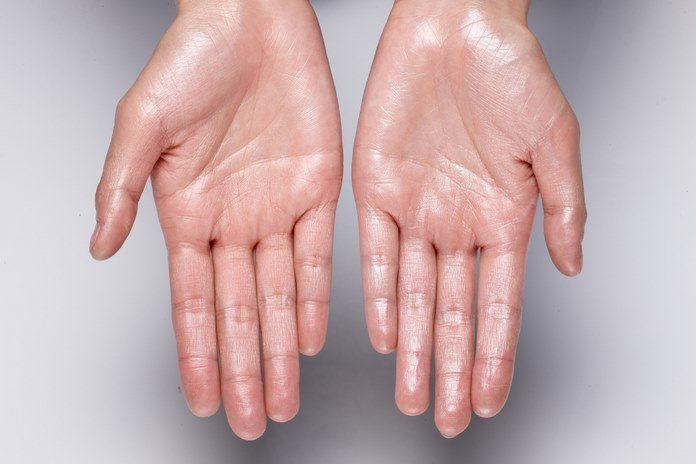Hyperhidrosis Symptoms

A majority of the people sweat when they exert themselves or exercise, are anxious, under stress, or are in a heated environment. The excessive sweating that hyperhidrosis patients experience exceeds the normal sweating levels. Sweating is a natural phenomenon that occurs in response to specific conditions such as physical activity, hot weather, feelings of anger or fear, and stress. In the case of hyperhidrosis, a person sweats more than usual with no apparent reason for sweating. However, the underlying cause of hyperhidrosis is dependent on the type of hyperhidrosis a person has. (1)
The type of hyperhidrosis that mostly affects the feet, hands, face, or underarms results in at least one episode per week and usually during the waking hours. In addition, sweating more often happens on both sides of the body. Sometimes there is excessive sweating which is an alarming sign of a more severe condition. It is important to seek medical help if you are seating heavily along with other symptoms like chest pain, nausea, or lightheadedness. Hyperhidrosis needs immediate medical help if your sweating is disrupting your daily routine.
Furthermore, hyperhidrosis needs treatment when excessive sweating is causing social withdrawal or emotional distress. Although sweating is not one of the things that needs medical treatment right away, if you suddenly start to sweat more than normal then it is worrisome. If a person is experiencing night sweats with no particular reason or causes behind it then they must visit a medical specialist to check for hyperhidrosis and start the treatment. According to medical specialists, hyperhidrosis causes excessive sweating that can disrupt your normal activities.
There is the occurrence of sudden episodes of excessive sweating for no apparent reason at least once a week and can have a damaging effect on your social life as well. However, simple changes in your lifestyle along with proper medication can help you a lot to ease your symptoms of hyperhidrosis. Following is the list of some most commonly occurring symptoms of hyperhidrosis:
- Wet or clammy soles of the feet
- Wet or clammy palms of the hands
- Frequent and excessive sweating
- Noticeable sweating soaking through clothes
- Constant worry about having sweat stains on clothes
- Irritation and painful skin issues, including bacterial or fungal infections
- Self-consciousness
- Reluctant to initiate physical contact
- Selecting employment where there is no need for human interaction
- Social withdrawal, that might lead to depression
- More worrying about body odor
- Spending a large amount of time every day dealing with sweat like wiping, changing clothes, placing pads or napkins under the arms
According to the experts, it is not certain why but excessive sweating during nighttime is not common for people suffering from primary hyperhidrosis. Following is the description of some commonly occurring symptoms of hyperhidrosis:
